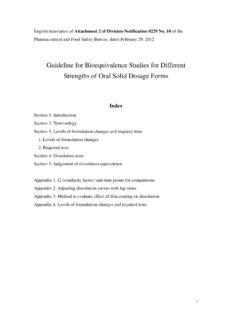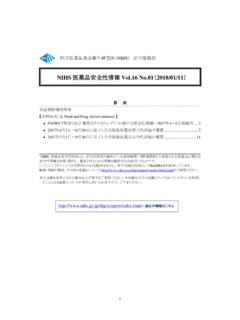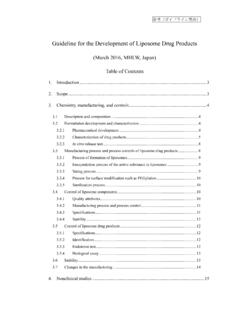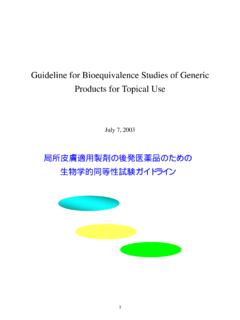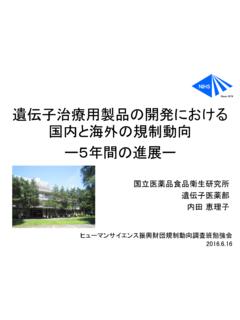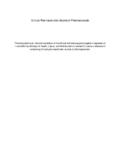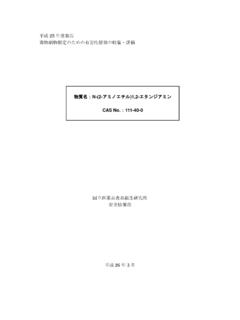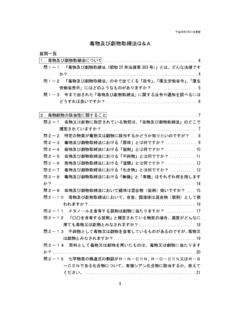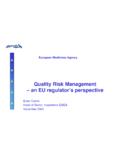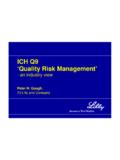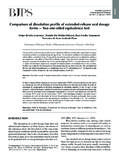Transcription of Guideline for Bioequivalence Studies for …
1 English translation of Attachment 3 of Division-Notification 0229 No. 10 of the Pharmaceutical and Food Safety Bureau, dated February 29, 2012. Guideline for Bioequivalence Studies for Formulation Changes of oral Solid dosage Forms Index Section 1: Introduction Section 2: Terminology Section 3: Levels of formulation changes and required tests 1. Levels of formulation changes 2. Required tests Section 4: Dissolution tests Section 5: Judgement of dissolution equivalence Appendix 1. f2 (similarity factor) and time points for comparisons Appendix 2. Adjusting dissolution curves with lag times Appendix 3. Method to evaluate effect of film coating on dissolution Appendix 4. Levels of formulation changes and required tests 1. Section 1: Introduction This Guideline describes the principles of procedures of Bioequivalence Studies for post-approval changes in the components and composition of oral solid dosage forms other than the active ingredients, which is hereafter called the formulation changes.
2 The objective of the Guideline is to assure the Bioequivalence between products before and after the formulation change. The tests required for Bioequivalence assessment differ depending on the levels of the formulation changes from the original product whose therapeutic efficacy and safety were established by clinical Studies or whose Bioequivalence to the innovator product was demonstrated by a human Bioequivalence study. Section 2: Terminology Standard formulation: The formulation for which therapeutic efficacy and safety were established by clinical Studies or Bioequivalence to the innovator product was demonstrated by a human Bioequivalence study. Reference product: The dissolution test (Sec. 4.) should be performed with three lots of the product before the formulation change, using the following test solution 1) or 2).
3 (limited to the paddle methods at 50rpm, with 6 vessels or more). Among the three lots, the one which shows intermediate dissolution should be selected as the reference product. In the case of Level A change, the specification test conditions can be used when the dissolution specifications are established in the specifications and test procedures of the reference product. When the average dissolutions of the three lots reach 85% within 15. min, any lots can be used as the reference product. 1) The specification test solution when the dissolution specifications are established in the specifications and test procedures. 2) Among the test solutions described in the dissolution conditions in Sec. 4., when the average dissolution of at least one lot reaches 85%, the test solution providing the slowest dissolution should be selected.
4 When the average dissolution of any of the lots does not reach 85 %, the test solution providing the fastest dissolution should be used. Test product: A product after the formulation change. It is recommended to use a lot manufactured at the same lot size as the full-scale production. However, a lot manufactured at a scale of not less than 1/10 of a full-scale production also can be used. 2. The manufacturing method of the test product and full-scale production products should be the same, and quality and bioavailability of both products should be equivalent. In the case of extended release products, the test product should not significantly differ from the reference product in size and shape of dosage form, specific gravity and release mechanism. The dissolution profiles of the test product should be similar to those of the reference product as required in Sec.
5 Of the Guideline for Bioequivalence Studies of Generic Products (an attachment of Division-Notification No. 487 of the Pharmaceutical and Food Safety Bureau dated, on December 22, 1997, (partial revision in Division-Notification 0229 No. 10 of the Pharmaceutical and Food Safety Bureau, dated February 29, 2012). Products containing poorly soluble drugs: See Sec. of the Guideline for Bioequivalence Studies of Generic Products. Section 3: Levels of formulation changes and required tests 1. Levels of formulation changes The level of formulation changes is calculated based on the standard formulation. The degree of the changes should be evaluated by separated-calculation of difference of content (%) regarding function of excipient and component as shown in Table 1 and Table 2. When the calculation is equal to or less than Level B, change level is B.)
6 When the calculation is more than Level B and equal to or less than Level C, the change level is C. When the calculation is more than Level C and equal to or less than Level D, the change level is D. The changes more than Level D are Level E. The level of the formulation changes of the following 1) - 3) is Level A irrespective of the levels in Table 1 and Table 2. 1) Changes of components described as "trace use". 2) Except narrow therapeutic range drugs, the change of excipients categorized as "Others" within the range not more than (w/w) where the total weight of formulation is not changed with compensation of the weight change by increasing or reducing diluting agents. 3) Except narrow therapeutic range drugs, the exchange of excipients categorized as "Others" in the same use within the range not more than (w/w) as sum of absolute values of difference of content (% w/w).
7 ( change of sweeteners to 3. other sweeteners). Except narrow therapeutic range drugs, when the change of the film coating weight is not more than (w/w) of core tablet and it is demonstrated that the film coating does not affect dissolution according to Appendix 3, the change level is B irrespective of the film coating change levels of Table 2. The highest level of these changes is defined as the formulation change level to the product. However, in the case of enteric-coated products, the changes in the diameter of the units having substantial enteric function from less than 4 mm to more than 4 mm or more, or vice versa, is Level E change, and Bioequivalence Studies at fed state should be additionally performed according to the Guideline for Bioequivalence Studies of Generic Products (Sec. 3. B.)
8 II. 1.), and estimated according to Sec. 3, A. II. 2. Table 1 Levels of Changes in Uncoated Product Difference of Content (% W/W ). Compared to Standard Formulation Function of Excipient and Component . Disintegranting agents Starch . Others . Binders . Lubricants Polishers Stearate salts . Others . Fluidizing agents Talc . Others . Diluting agents . Others . (Preservatives, Sweeteners, Stabilizers, etc.) 1). Sum of absolute values of difference of content (%) of changed components . 1). A change level of excipients categorized as "Others" is also determined by separated-calculation of difference of content (%). regarding the respective use. Ignore the components of which composition is described as "trace use". 4. Table 2 Levels of Changes in Coated Product Difference of Content or Rate of Change (%.
9 W/W). Compared to Standard Formulation Part Function of Excipient and Component . Core Disintegranting agents Starch . Others . Binders . Lubricants Polishers Stearate salts . Others . Fluidizing agents Talc . Others . Diluting agents . Others . (Preservatives, Sweeteners, Stabilizers, etc.) 1). Sum of absolute values of difference of content (%) of changed . components Film coating 2) Sum of absolute values of difference of content (%) of changed . components in film coating layer 1). Rate of change (%) of film coating weight/cm2 of surface area of . core 3). Sugar coating Sum of absolute values of difference of content (%) of changed . components in sugar coating layer 1). Rate of change (%) of sugar-coating weight/cm2 of surface area . of core 3). 1). A level of changes of excipients categorized as "Others" is also determined by separated-calculation of difference of content (%) regarding respective use.
10 Ignore the components of which composition is described as "trace use". 2). All coatings, such as water-proofing coating, under coating, enteric coating, and release control coating, are included except sugar coating. 3). The surface area of the core is calculated depending on the shape of the formulation. When it is impossible to calculate the surface area of the shape, it is allowed to assume that the shape of the core is a sphere and the specific gravity of the core is not changed with the formulation change. 2. Required Tests Level A. When the dissolution test is established in the specifications and test procedures of the reference product, the dissolution test should be performed using 12 vessels or more under the testing conditions specified in the specifications. However, when it is not established, perform the dissolution test under the condition shown in Sec.
